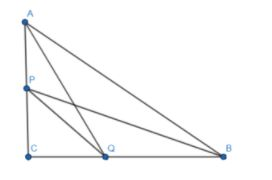
If P and Q are points on sides CA and CB respectively of $\Delta ABC$, right angled at C, prove that $\left( A{{Q}^{2}}+B{{P}^{2}} \right)=\left( A{{B}^{2}}+P{{Q}^{2}} \right).$
Answer
577.5k+ views
Hint: We start solving the given problem by considering the right-angled triangles $ABC,PBC,ACQ$ and $PCQ$. Then we apply Pythagora's theorem for all the four right angled triangles. We get four equations. Then by using those four equations, and solving them we prove that $\left( A{{Q}^{2}}+B{{P}^{2}} \right)=\left( A{{B}^{2}}+P{{Q}^{2}} \right).$
Complete step-by-step answer:
Let us first consider $\Delta ABC$, right angled at C and let us consider the point P on the side CA and point Q on the side CB.

By seeing the above diagram, we can say that the triangles ABC, PBC, ACQ and PCQ are all right angled triangles.
Let us consider the well known Pythagoras theorem, that is,
In a right angled triangle, the square of the hypotenuse is equal to the sum of the squares of the perpendicular sides, that is,
In a right angled $\Delta XYZ$, $\angle Z={{90}^{\circ}}$, then $X{{Y}^{2}}=X{{Z}^{2}}+Y{{Z}^{2}}$ .
Now, we apply the Pythagoras theorem to $\Delta ABC$, we get,
$A{{B}^{2}}=A{{C}^{2}}+C{{B}^{2}}.............\left( 1 \right)$
By applying the Pythagoras theorem to $\Delta PCQ$, we get,
$P{{Q}^{2}}=P{{C}^{2}}+C{{Q}^{2}}.............\left( 2 \right)$
By applying the Pythagoras theorem to $\Delta ACQ$, we get,
$A{{Q}^{2}}=A{{C}^{2}}+C{{Q}^{2}}.............\left( 3 \right)$
Now, we apply the Pythagoras theorem to $\Delta PBC$, we get,
$P{{B}^{2}}=P{{C}^{2}}+C{{B}^{2}}.............\left( 4 \right)$
Now, by adding the equations (3) and (4), we get,
$\begin{align}
& A{{Q}^{2}}+P{{B}^{2}}=A{{C}^{2}}+C{{Q}^{2}}+P{{C}^{2}}+C{{B}^{2}} \\
& \Rightarrow A{{Q}^{2}}+P{{B}^{2}}=\left( A{{C}^{2}}+C{{B}^{2}} \right)+\left( P{{C}^{2}}+C{{Q}^{2}} \right)............\left( 5 \right) \\
\end{align}$
Let us substitute the equation (1) and equation (2) in equation (5), we get,
$A{{Q}^{2}}+P{{B}^{2}}=A{{B}^{2}}+P{{Q}^{2}}$
Therefore, $A{{Q}^{2}}+P{{B}^{2}}=A{{B}^{2}}+P{{Q}^{2}}$
Hence proved.
Note: The possibilities of making mistakes in this type of problems are:
One may make a mistake by considering the Pythagoras theorem as the square of the hypotenuse is equal to the square of the sum of the perpendicular sides, that is, one may mistake the Pythagoras formula as $X{{Y}^{2}}={{\left( XZ+YZ \right)}^{2}}$ for the $\Delta XYZ$ with $\angle Z={{90}^{\circ}}$.
Complete step-by-step answer:
Let us first consider $\Delta ABC$, right angled at C and let us consider the point P on the side CA and point Q on the side CB.

By seeing the above diagram, we can say that the triangles ABC, PBC, ACQ and PCQ are all right angled triangles.
Let us consider the well known Pythagoras theorem, that is,
In a right angled triangle, the square of the hypotenuse is equal to the sum of the squares of the perpendicular sides, that is,
In a right angled $\Delta XYZ$, $\angle Z={{90}^{\circ}}$, then $X{{Y}^{2}}=X{{Z}^{2}}+Y{{Z}^{2}}$ .
Now, we apply the Pythagoras theorem to $\Delta ABC$, we get,
$A{{B}^{2}}=A{{C}^{2}}+C{{B}^{2}}.............\left( 1 \right)$
By applying the Pythagoras theorem to $\Delta PCQ$, we get,
$P{{Q}^{2}}=P{{C}^{2}}+C{{Q}^{2}}.............\left( 2 \right)$
By applying the Pythagoras theorem to $\Delta ACQ$, we get,
$A{{Q}^{2}}=A{{C}^{2}}+C{{Q}^{2}}.............\left( 3 \right)$
Now, we apply the Pythagoras theorem to $\Delta PBC$, we get,
$P{{B}^{2}}=P{{C}^{2}}+C{{B}^{2}}.............\left( 4 \right)$
Now, by adding the equations (3) and (4), we get,
$\begin{align}
& A{{Q}^{2}}+P{{B}^{2}}=A{{C}^{2}}+C{{Q}^{2}}+P{{C}^{2}}+C{{B}^{2}} \\
& \Rightarrow A{{Q}^{2}}+P{{B}^{2}}=\left( A{{C}^{2}}+C{{B}^{2}} \right)+\left( P{{C}^{2}}+C{{Q}^{2}} \right)............\left( 5 \right) \\
\end{align}$
Let us substitute the equation (1) and equation (2) in equation (5), we get,
$A{{Q}^{2}}+P{{B}^{2}}=A{{B}^{2}}+P{{Q}^{2}}$
Therefore, $A{{Q}^{2}}+P{{B}^{2}}=A{{B}^{2}}+P{{Q}^{2}}$
Hence proved.
Note: The possibilities of making mistakes in this type of problems are:
One may make a mistake by considering the Pythagoras theorem as the square of the hypotenuse is equal to the square of the sum of the perpendicular sides, that is, one may mistake the Pythagoras formula as $X{{Y}^{2}}={{\left( XZ+YZ \right)}^{2}}$ for the $\Delta XYZ$ with $\angle Z={{90}^{\circ}}$.
Recently Updated Pages
Two men on either side of the cliff 90m height observe class 10 maths CBSE

What happens to glucose which enters nephron along class 10 biology CBSE

Cutting of the Chinese melon means A The business and class 10 social science CBSE

Write a dialogue with at least ten utterances between class 10 english CBSE

Show an aquatic food chain using the following organisms class 10 biology CBSE

A circle is inscribed in an equilateral triangle and class 10 maths CBSE

Trending doubts
Why is there a time difference of about 5 hours between class 10 social science CBSE

Write a letter to the principal requesting him to grant class 10 english CBSE

What is the median of the first 10 natural numbers class 10 maths CBSE

The Equation xxx + 2 is Satisfied when x is Equal to Class 10 Maths

Which of the following does not have a fundamental class 10 physics CBSE

State and prove converse of BPT Basic Proportionality class 10 maths CBSE




